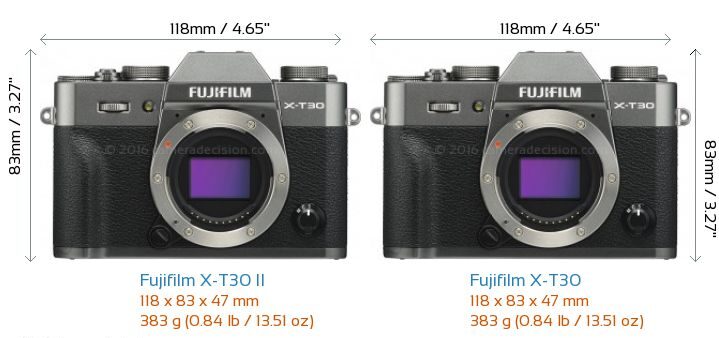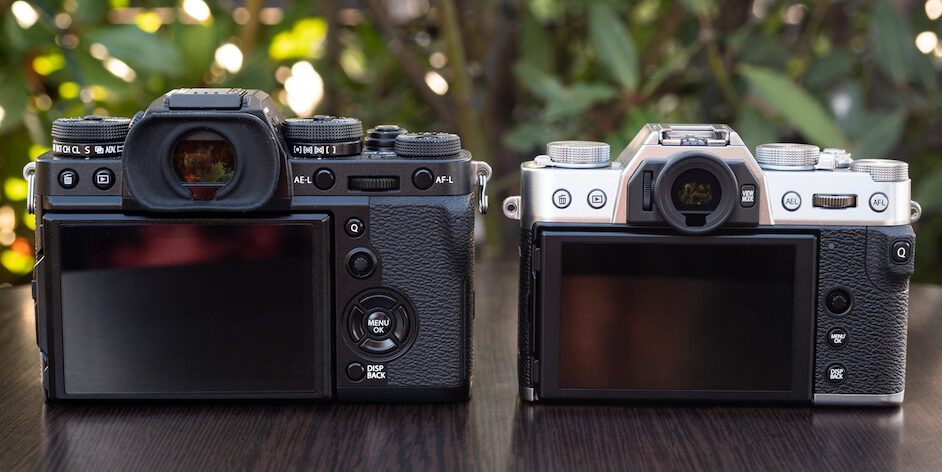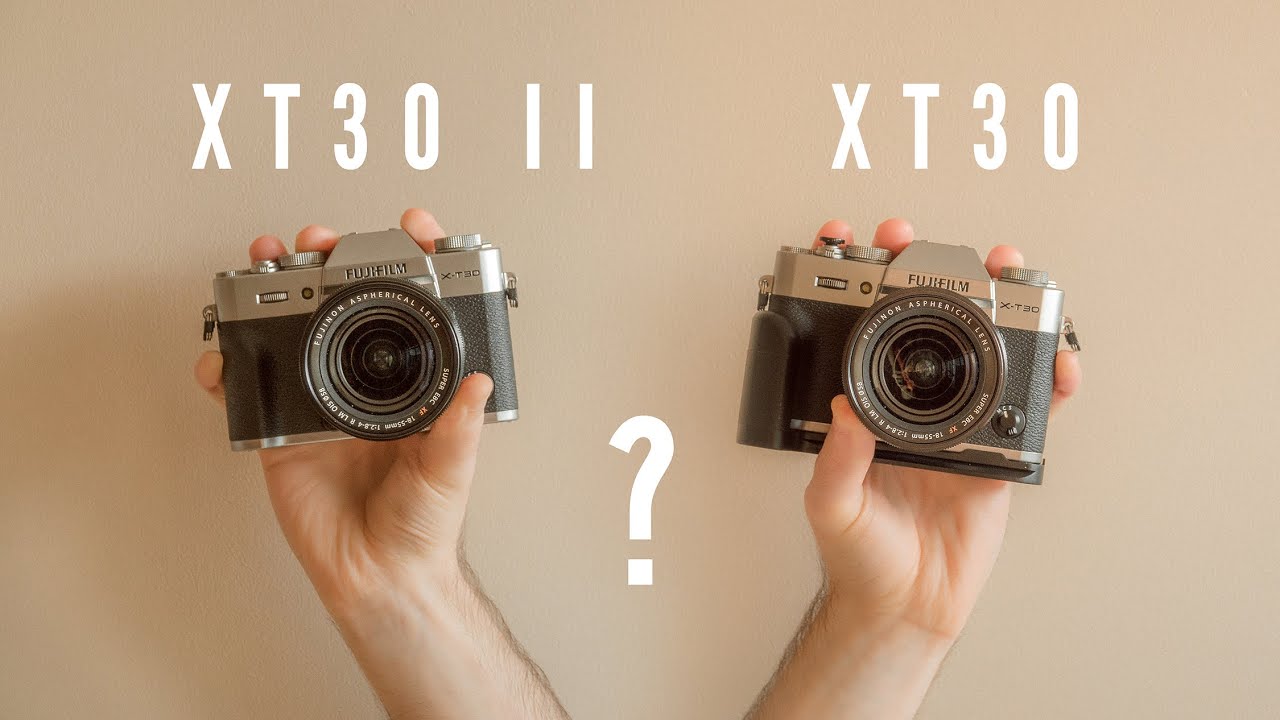Distance Converter
Like its predecessors, the Fujifilm X-T30 was released in February 2019 and offers most of the T3’s X features in a smaller, less expensive chassis.
The X-T30’s hardware remains the same, except for the rear screen, making the X-T30 II primarily a software improvement.
Five differences you should know about the Fujifilm x T30 vs x T30 II are listed in this article. But first, here’s a long list of all the similarities they share:
- APS-C BSI sensor with 26 MP
- ISO 160-12800 (80 to 51200 with extended range) (80 to 51200 with extended range)
- AF system hybrid with up to 425 points
- 8fps driving speed with mechanical shutter
- Drive speed is 20fps with live view, no power loss, and (30fps with 1.25x cropping)
- Up to 30p in 4K and DCI 4K, F-Log
- Internal 8-bit 4:2:0. recording
- 10-bit 4:2:2 . HDMI video
- Headphone output and microphone input (via USB C and adapter)
- 0.6x magnification and 0.39-inch OLED viewfinder with 2.36M dots.
- One SD card slot (UHS-I)
- Battery NP-W126S (have more or less the same battery life rating)
- Dimensions and Design (118.4 x 82.8 x 46.8mm)
- Weight (X-T30 II is 5g lighter) (X-T30 II is 5g lighter)
Which Are The Differences Between Fujifilm x T30 vs x T30 II?

Fujifilm x T30 vs x T30 II: Image Settings And Movie Simulation
Classic Neg and Eterna Bleach Bypass are two new film simulation modes (image color profiles) available on the X-T30 II.
The X-Pro3 marked the introduction of Classic Neg. Similar to Classic Chrome, but with higher saturation and a wider range of color tones. It is among the most striking looks that Fujifilm offers.
The silver halide film processing technique is modeled after bleach bypass. There is a lot of contrast but little saturation.
The X-T30 II inherits extra settings from the original model in addition to the extra image profiles. Which are:
- Clarity
- Half-step tone curve adjustment (called highlights and shadows on the X-T30 but with 1-step adjustment)
- Auto White Balance White Priority and Ambience Priority
- With monochromatic color, you can choose any color tone for the image (with the original X-T30, there are only two options: cooler or warmer).
- Color Chrome FX Blue, which intensifies the color blue.
The HDR mode is another feature that was carried over from the flagship devices. It combines three photos, enhancing the shadow and highlighting features. It only functions with JPG (for the final output).
Fujifilm x T30 vs x T30 II: Autofocus

The X-T30 II inherits the most recent software updates introduced with the X-T4, which were subsequently also deployed on the X-T3 via firmware update, even though the AF system is identical with an equal number of points (425).
This indicates that the X-T30 II has quicker focusing (0.02s locking speed), more accurate tracking (2x more accurate success rate), and better face/eye identification.
With a rating of -6Ev at f1.4 or -7Ev at 50mm F1.0 (vs. -3Ev at f1.4 on the original X-T30), focusing in low light has also improved.
According to my observations after comparing the X-T3 and X-T4, the changes are not revolutionary, but I did discover that the Wide/Tracking mode is more dependable and that the new AF software has a better understanding of what and where the subject is.
Face/eye detection makes it less likely to lose sight of the subject if they briefly turn 90 degrees or face the camera in the opposite direction.
Fujifilm x T30 vs x T30 II: Video Tidbits
For those who are interested in movie functionality, there are two variances in this.
The X-T30 II has a restriction of 30 minutes per clip in 4K, which is an improvement over the X-10 T30’s minute cap.
The High-Speed setting is the next option for creating slow-motion videos. In comparison to the X-T30, the mark II model can record at a maximum frame rate of 240.
Fujifilm x T30 vs x T30 II: LCD Screen

Both cameras have a touch-sensitive back LCD panel that can tilt up or down.
The only difference is that it has a higher resolution (1.68M dots vs. 1.04M dots on the original model) on the X-T30 II.
Fujifilm x T30 vs x T30 II: Price
You can get the X-T30 for $800, £850, or €800. The X-T30 is still available as of the time this article was published, however, it will probably soon be phased out.
At $900 or £770, the X-T30 II is a little more pricey (no Euro price yet at the time of publishing). And before you say the price in the UK can’t be accurate, it is. The mark II model appears to be less expensive in the UK than the older, original model.
Conclusion
The Fujifilm x T30 vs x T30 II is identical in size, shape, and hardware components like the sensor and CPU.
All enhancements of the mark II model are software-based (apart from increasing the resolution of the LCD), so the X-T30 can get them through firmware. Similar actions were taken by Fujifilm with the X-E2s, which replaced the X-E2 and X-T3, receiving most of the improvements introduced on the X-T4 (with the exception of IBIS and the larger battery, of course. ).
It’s unclear if Fujifilm will give the X-T30 a longer lifespan or give it up for the short term and stick with the II mark.
I recommend delaying the purchase of the mark II model. In the near future, you can find the X-T30 for less money and with luck, a firmware upgrade will make them comparable.
